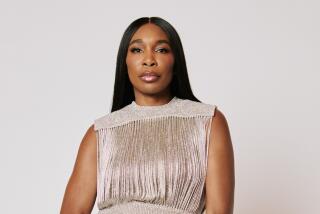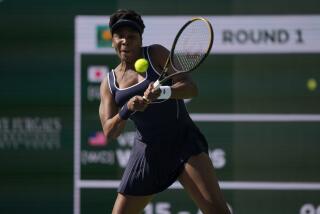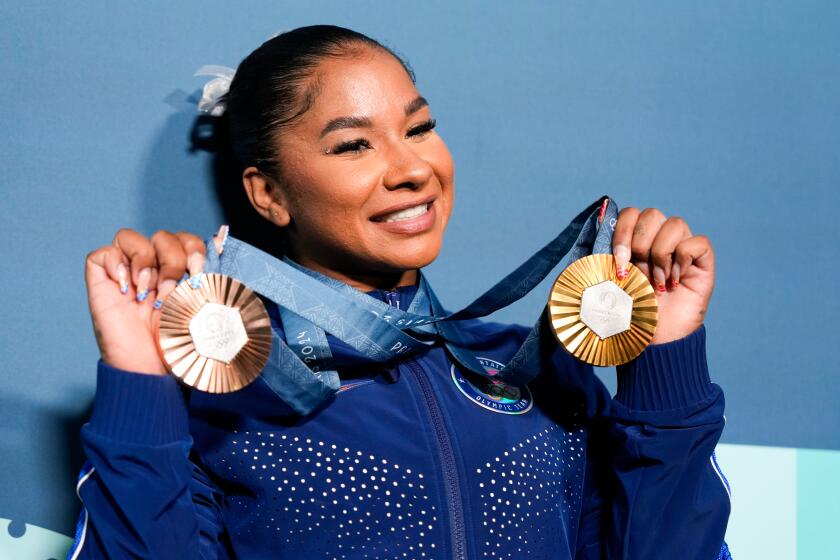Minority of One
Computer wisdom finally caught up with conventional wisdom in women’s tennis today.
This is why the news that Venus Williams officially became No. 1 isn’t more of a blockbuster announcement. If you walked into any sports bar last week--managing to pull fans away from curling and hockey--and quizzed people about the top-ranked player in the world, undoubtedly, the answer would have been Williams, not Jennifer Capriati.
Surely, hadn’t Williams been No. 1 already after winning Wimbledon and the U.S. Open the last two years? And, if not, why had it taken so long?
The computer is the partial culprit, much-maligned and all, but of course, not as much as Olympic figure skating judges or the bowl championship series. It artificially propped up Martina Hingis, who benefited by playing more and winning smaller, less prestigious events. Even Lindsay Davenport seemed slightly embarrassed by finishing last year ranked No. 1, admitting Williams was the true top player.
Williams, too, had something to do with the strangeness. She played a limited schedule last year, and no events after the U.S. Open because of the terrorist attacks and an injured wrist.
Just as quixotically, she took a different approach in 2002. Having been criticized for playing too little, she flipped that notion and has been in five tournaments the first eight weeks of the year.
Williams left her Florida home on Dec. 27 for Australia and has been on the road since, starting at Gold Coast, Queensland, winding through Paris and Antwerp, Belgium, and finishing in Dubai.
Call it coincidence or providence, but, in a larger sense, the timing couldn’t have worked out better. Williams has become the first African-American, male or female, to be ranked No. 1 by their professional tennis association. Arthur Ashe reached No. 2 on the ATP’s computer rankings in 1975, and Althea Gibson was ranked No. 1 in 1957 by a world panel, long before the WTA computer rankings started in 1975.
The historic moment arrived near the end of February, Black History Month. It came two days after another African-American player, Alexandra Stevenson--a childhood friend of Williams from their Southern California days--reached the tour final in Memphis, losing to Lisa Raymond. And it dawned only a day after another African-American, James Blake, played in the Memphis final against his Davis Cup teammate, Andy Roddick, also losing.
There were more than thoughts of Ashe and Gibson when Williams spoke about her latest accomplishment on a ragged phone line on Saturday from Dubai. An associate of Gibson’s got on the conference call, warmly congratulated Williams, and said that Gibson wanted to personally offer kudos but was unable to do so.
“It would be foolish to forget Althea Gibson,” Williams said. “She was the first. And more than anything, I just feel proud to represent America in my sport.”
The dream--of winning Grand Slams and reaching No. 1--was not hers at the start. Richard Williams, her father, had the notion first when Venus and her younger sister Serena were growing up in Compton. He boldly predicted Venus would become No. 1. He even said Serena would be better than Venus, which did happen, briefly, when Serena won the U.S. Open in 1999.
“I thought he was telling the truth,” Venus said of the No. 1 prediction. “I was just being the daughter of a proud father. And more than anything, I think he knew he put the work in and that we were listening to him, and I think that’s why he had that confidence to say that myself and Serena would be Grand Slam champions.
“Right now, we are some of the best players in the game, I guess, in history, and I just think that I give a lot of credit to my dad for that.”
Her mother and coach, Oracene, should receive just as much credit. She has been with her daughter since the start of this final determined charge toward No. 1. Increasingly, Williams has taken charge of her career as she has matured. At the Australian Open, she played through the pain of an injured knee, hinting she didn’t consult her parents, and fought her way to the quarterfinals though hampered, losing to a resurgent Monica Seles.
Behind the scenes, she found support from her Italian boyfriend, Davide, who was with her in Australia as well as the European stretch and final stop in Dubai. It hasn’t been easy. She played three consecutive weeks, the first time she had done so since October 1998.
In the Paris final, Williams defeated local favorite Amelie Mauresmo and took on another local favorite, Justine Henin, a week later in the Antwerp final. Williams has won three titles this year and lost in the semifinals to Sandrine Testud of France on Friday in Dubai.
“I did intend to be on the road,” said Williams, who added the Antwerp tournament when she realized how close she was to No. 1. “I gave my full commitment for the first two months of the year. I knew it would be really tough, and mentally I’ve prepared to not be at home. But I really miss my dog ... and I miss Serena too. I miss the States more than anything. I haven’t really had a chance to watch the Olympics, so I missed out on a few things.”
Lately, the reigns at No. 1 have been short. Williams is the fourth player in the last five months to reach No. 1. Capriati, Davenport and Hingis are the others. Williams and her sister Serena will not be playing at Indian Wells next week, not surprising after last year’s controversy, in which they were booed by the crowd. Venus pulled out of a scheduled semifinal against Serena because of an injury.
“Well, all in all, it was just basically an incredible scene last year in Indian Wells, but that’s part of sports, playing with the good and the bad,” Venus said.
Whether she is passed by Capriati this week in Scottsdale or by not playing at Indian Wells, Williams doesn’t appear overly concerned. She reached No. 1 her special way, and why be any different now?
“I think the best part is that I’ve enjoyed myself along the way and that I have not limited myself just to playing tennis or made myself believe that that’s the only thing in life,” she said. “I’ve always been doing things at the same time and having a career; for me that’s the best part.”
*
(BEGIN TEXT OF INFOBOX)
Pulling Rank
The following is a list of the 10 players who have held the No.1 ranking, and total weeks at that spot, since computer rankings were first introduced on Nov. 3, 1975:
Steffi Graf (Germany) 378
Martina Navratilova (U.S.) 331
Chris Evert (U.S.) 262
Martina Hingis (Switzerland) 209
Monica Seles (U.S.) 178
Lindsay Davenport (U.S.) 37
Tracy Austin (U.S.) 22
Arantxa Sanchez-Vicario (Spain) 11
Jennifer Capriati (U.S.) 9
Venus Williams (U.S.) 1
*
The Times’ Rankings
(text of infobox not included)
More to Read
Go beyond the scoreboard
Get the latest on L.A.'s teams in the daily Sports Report newsletter.
You may occasionally receive promotional content from the Los Angeles Times.









